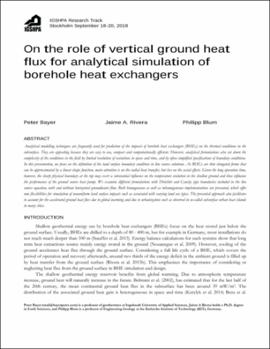| dc.contributor.author | Bayer, Peter | |
| dc.contributor.author | Rivera, Jaime A. | |
| dc.contributor.author | Blum, Philipp | |
| dc.contributor.other | IGSHPA Research Track (2018) | |
| dc.date.accessioned | 2018-08-28T17:59:04Z | |
| dc.date.available | 2018-08-28T17:59:04Z | |
| dc.date.issued | 2018 | |
| dc.identifier | oksd_ighspa_2018_bayer | |
| dc.identifier.uri | https://hdl.handle.net/11244/301591 | |
| dc.description.abstract | Analytical modelling techniques are frequently used for prediction of the impacts of borehole heat exchangers (BHEs) on the thermal conditions in the subsurface. They are appealing because they are easy to use, compact and computationally efficient. However, analytical formulations also cut down the complexity of the conditions in the field by limited resolution of variations in space and time, and by often simplified specifications of boundary conditions. In this presentation, we focus on the definition of the land surface boundary condition in line source solutions. As BHEs are thin elongated forms that can be approximated by a linear shape function, main attention is on the radial heat transfer, but less on the axial effects. Given the long operation time, however, the sharp physical boundary at the top may exert a substantial influence on the temperature evolution in the shallow ground and thus influence the performance of the ground source heat pump. We examine different formulations with Dirichlet and Cauchy type boundaries included in the line source equation, with and without horizontal groundwater flow. Both homogeneous as well as inhomogeneous implementations are presented, which offer new flexibilities for simulation of nonuniform land surface impacts such as associated with varying land use types. The presented approach also facilitates to account for the accelerated ground heat flux due to global warming and due to urbanization such as observed in so-called subsurface urban heat islands in many cities. | |
| dc.format | application/pdf | |
| dc.language | en_US | |
| dc.publisher | International Ground Source Heat Pump Association | |
| dc.rights | In the Oklahoma State University Library's institutional repository this paper is made available through the open access principles and the terms of agreement/consent between the author(s) and the publisher. The permission policy on the use, reproduction or distribution of the article falls under fair use for educational, scholarship, and research purposes. Contact Digital Resources and Discovery Services at lib-dls@okstate.edu or 405-744-9161 for further information. | |
| dc.title | On the role of vertical ground heat flux for analytical simulation of borehole heat exchangers | |
| osu.filename | oksd_ighspa_2018_bayer.pdf | |
| dc.identifier.doi | 10.22488/okstate.18.000007 | |
| dc.type.genre | Conference proceedings | |
| dc.type.material | Text | |
